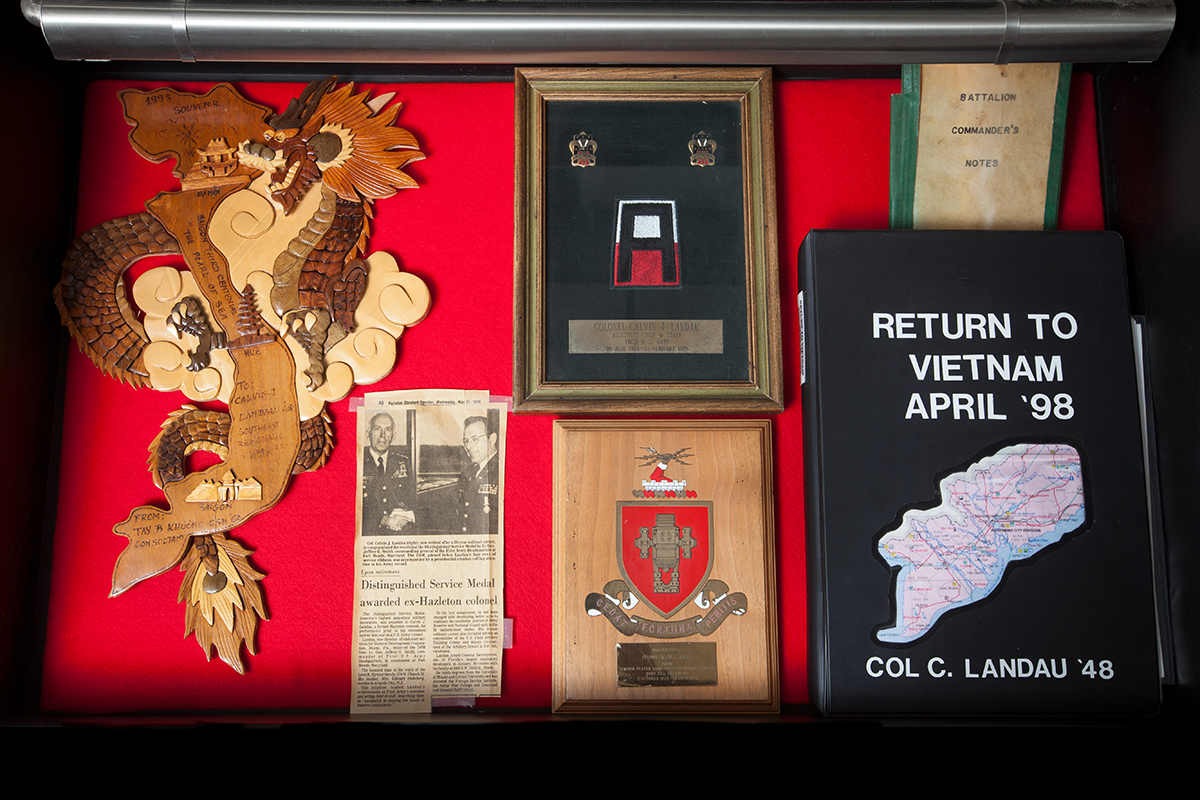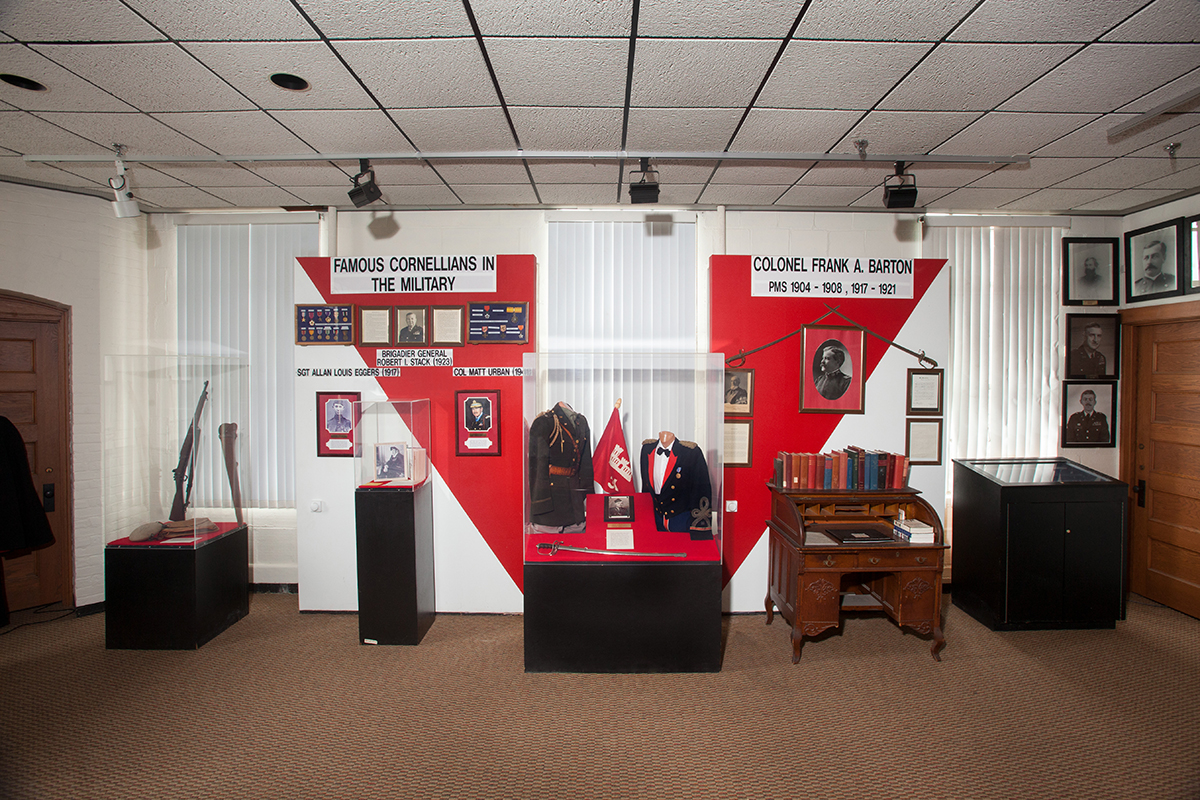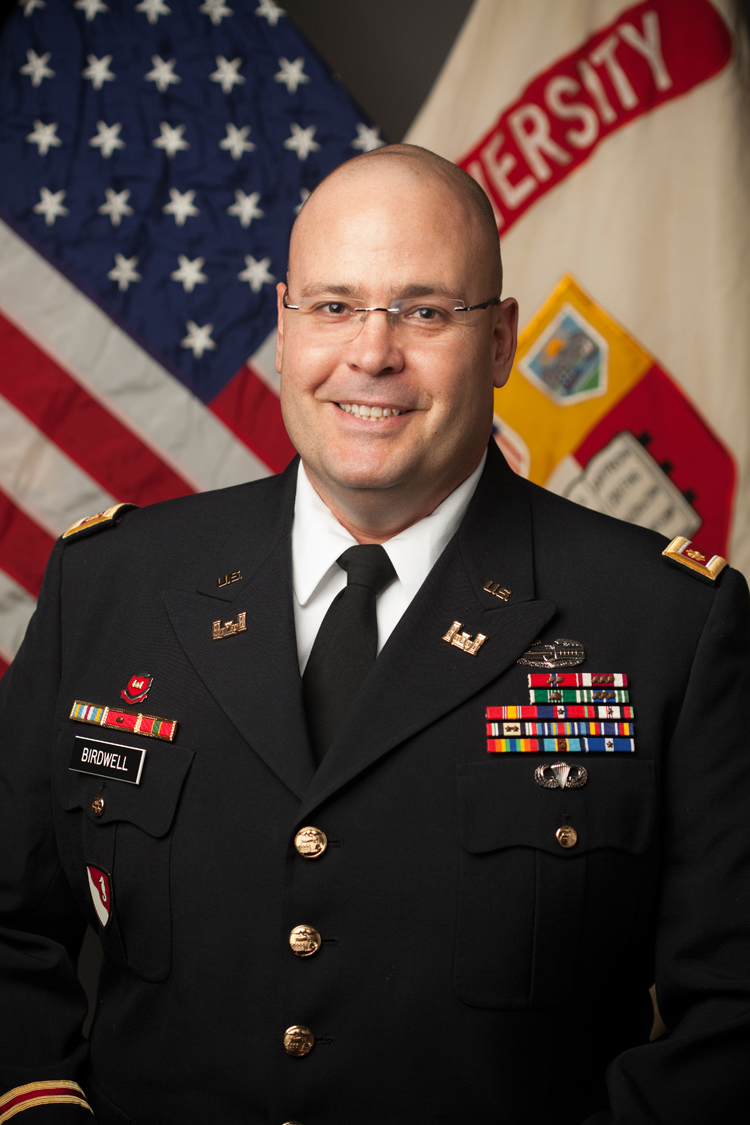A salute to Cornell's restored military museum collection
By Melanie Lefkowitz


Soon after Maj. Trey Birdwell became Cornell’s Army ROTC executive officer in 2014, he discovered a large collection of military artifacts dating to World War I, but he feared it wasn’t being stored correctly.
Hundred-year-old uniforms were stuffed into trunks; others hung from hangers, exposed to sunlight. Historic photographs were silvering and sticking to their frames.
“I didn’t know what to do with it, but I knew we needed help,” Birdwell says.
He connected with then-University Archivist Elaine Engst, M.A. ’72, and Denise Green ’07, assistant professor in the College of Human Ecology’s Department of Fiber Science & Apparel Design (FSAD) and director of the Cornell Costume and Textile Collection.
Their collaboration launched a yearlong, cross-departmental effort, including ROTC, FSAD and archivists and preservationists from Cornell University Library. The team preserved and organized uniforms, correspondence, photographs, tactical manuals, rare books and other items – and in the process shed new light on Cornell’s long history of hosting the military on campus.
“We knew there were some really special things there – when Trey came in, he revitalized the efforts to do something about it,” says Engst’s successor, Evan Earle ’02, M.S. ’13. “And seeing everything inventoried made it clear just how important it was.”
The renovation of the Wortham Military Museum, on Barton’s third floor, is nearing completion. Displays honor prominent Cornellians who served in the armed forces, including Col. Frank A. Barton, Class of 1891, one of the first two Cornellians to earn a U.S. Army commission and the university’s first ROTC commander; and Brig. Gen. Robert I. Stack, who entered Cornell with the Class of 1920, best known for taking Nazi leader Hermann Goering into custody after World War II.
“It helps turn the history into something you can touch and feel and see, rather than just reading about it in a book,” Birdwell says. “I think it’s very important to the cadets that they get a chance to see what came before – especially in this day and age, when fewer than 1 percent of U.S. citizens serve in the armed forces. That there’s been a strong sense of service in the military at Cornell is something to be celebrated.”

As New York state’s land-grant university, Cornell for decades required all male students spend two years studying military tactics, and it has the only uninterrupted ROTC program in the Ivy League. The artifacts in Barton offer rich details and stories about generations of students who served their country with distinction, including Matt Urban ’41, a World War II Medal of Honor winner, and Edward Tinkham, Class of 1916, who organized a Cornell unit in the American Ambulance Field Service. The unit, which was commanded by Tinkham and arrived in France in April 1917 during World War I, was the first American fighting unit to carry the American flag to the front.
Project will create online ‘Roll of Honor’
Two Norway spruce pines at the Delta Kappa Epsilon fraternity house on South Avenue – planted by Theodore Roosevelt – honor the sacrifice of Clifton Beckwith Brown, Class of 1900. He became the first Cornellian to give his life for his country when he was killed in the Spanish-American War’s Battle of San Juan Hill in 1898.
Though the pines are among more than a dozen campus memorials honoring Cornellians killed in action, no single, comprehensive Cornell memorial exists. But efforts to create one are now underway.
University Archivist Evan Earle is building an online database of all Cornell alumni killed in action to honor their contributions and their memory. Students of William Arms, professor emeritus of computing and information science, have assisted with website development.
“From the beginning, Cornell has had a strong relationship with the military, because it was a land-grant university,” Earle says. “This is a very significant part of Cornell’s history.”
For more information about this effort, contact Earle at efe4@cornell.edu.
Preserving the uniforms provides both a service to Cornell and a valuable learning experience for students, Green says.
Catherine Blumenkamp, a graduate student in the field of apparel design, was working on the “150 Years of Cornell Student Fashion” exhibition a year ago when she came across a 1912 Cornell Cadet Corps uniform. She helped put together a small exhibit of five military uniforms for Charter Day Weekend in 2015. Jackie Fogarty ’18, a fashion design student, helped ROTC catalog, store and create a digital database for all its uniforms – and as she did so, she unearthed stories about the clothes and those who wore them.
“Military uniforms are so complex – each and every detail has specific meaning,” Green says. “To read these garments was a very interesting educational task for our students. We know clothes are loaded with meaning and serve as communication devices in a lot of different ways, but it’s often very subtle. With these military uniforms, it’s very explicit – but you have to know how to read them.
“It was wonderful to bring together the knowledge of the ROTC folks with our understanding of how to care for, store and catalog garments, to produce a valuable resource for students, researchers and the general public.”
Some uniforms will remain on display at Barton, while others have been moved into storage – folded in acid-free boxes, protected from light. The museum also has been painted, and its windows and lights repaired, though some larger-scale work has yet to be completed.
Photographs have been restored and preserved by library conservators, and framed reproductions are displayed in the museum. Archivists removed about 10 boxes of documents that have been cataloged and stored in temperature-controlled vaults in the library’s Division of Rare and Manuscript Collections.
“Before, they were just sitting here,” Birdwell says. “Now they’re available for research.”
Melanie Lefkowitz is a staff writer and editor at Cornell University Library.
Media Contact
Get Cornell news delivered right to your inbox.
Subscribe